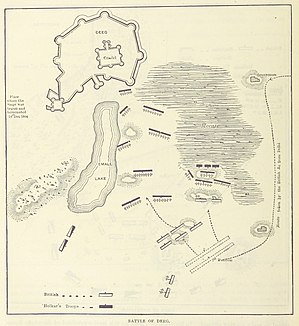Deeg
Deeg
जल महलों की नगरी | |
|---|---|
Town | |
 Deeg Palace or Jal Mahal Deeg | |
 Deeg Fort | |
| Coordinates: 27°28′N 77°20′E / 27.47°N 77.33°ECoordinates: 27°28′N 77°20′E / 27.47°N 77.33°E | |
| Country | |
| State | Rajasthan |
| District | Bharatpur |
| Founded by | Badan Singh |
| Government | |
| • Type | Congress |
| Elevation | 174 m (571 ft) |
| Population (2011) | |
| • Town | 44,999 |
| • Urban | 44,999 |
| • Rural | 181,711 |
| Languages | |
| • Official | Hindi, Braj Bhasa |
| Time zone | UTC+5:30 (IST) |
| Vehicle registration | RJ05 |
Deeg is a historical town and a municipality in Bharatpur district in the state of Rajasthan, India. It is situated 32 kilometres (20 mi) north of Bharatpur and 98 kilometres (61 mi) northwest of Agra.
In Hindu mythology, Deeg was situated along the parikrama path of Krishna, which started at Goverdhan, 14 kilometres (8.7 mi) from Deeg. Some people[who?] identify it as the ancient town of "Dirgha" or "Dirghapur" mentioned in the epic Skanda Purana. Deeg was the first capital of the Sinsinwar Hindu Jat state of Bharatpur, when Maharaja Badan Singh was proclaimed its ruler in 1722. In 1730, Maharaja Suraj Mal built the strong fortress of Deeg. After Suraj Mal moved the capital to Bharatpur, Deeg became the second capital of the rulers of Bharatpur princely state. It is known for its number of forts, palaces, gardens and fountains.
Geography[edit]
Deeg is located at 27°28′N 77°20′E / 27.47°N 77.33°E.[1] It has an average elevation of 174 m (571 ft).
History[edit]
After acquiring the throne, Maharaja Badan Singh chose Deeg as the place for his stronghold and capital. Hence, he initiated the construction of the Deeg Palace here. Being the capital of the Jat rulers and located at a distance of just about 32 km from Bharatpur, his palace served as a summer mansion for the royal family. He became the founder of Jat House in Bharatpur and under his reign, the place gained immense prosperity and urbanisation. In fact, Surajmal, son of Badan Singh is often hailed as the hero of the Jat dynasty. Owing to its great location, architectural beauty and grandeur, the palace caught the attention of many dynasties and almost constantly under the threat from Mughals. Hence, in order to protect the stunning Deeg Palace against the attack from invader, Maharaja Suraj Mal ordered the construction of a mighty fortress around the palace.
During 1804, both the Battle of Deeg and the Siege of Deeg brought the British East India Company into conflict with Bharatpur's Jat rulers and their Maratha allies for control of the area.
Architecture[edit]
The palace complex together with its water gardens was a summer retreat for the maharajas of Bharatpur. The layout comprises several palaces called bhawans, interwoven within series of charbaghs and water gardens. The major Bhawans are Gopal Bhawan, Divan I Khas or the Kishan Bhawan, Wrestling palace or Nand Bhawan, Keshav Bhawan, Hardev Bhawan, Suraj Bhawan and symmetrically arranged twin pavilions of Sawan & Bhadon.[2]
Demographics[edit]
As of 2011[update] India census,[3] Deeg had a population of 44,999. Males constitute 54% of the population and females 46%. Deeg has an average literacy rate of 75.61%, higher than the national average of 74.04%: male literacy is 85.73% and, female literacy is 64.23%. In Deeg, 17% of the population is under 6 years of age.
Sex ratio of Deeg is 886
Attractions[edit]
- Deeg Palace with its 900 fountains, which operate twice a year during Braj Holi festival in February/ March and the Avamasaya festival in September. There is a Jawahar exhibition fair is held every year around September. The Deeg Palace museum is closed on Fridays.
- Deeg fort is known for its security and force.
References[edit]
- ↑ Falling Rain Genomics, Inc - Deeg
- ↑ Chugh, Bharat; Chugh, Shalini (2014). Deeg Palace: Its Romance & Wonder. Niyogi Books, India. ISBN 9789383098538.
- ↑ "Census of India 2001: Data from the 2001 Census, including cities, villages and towns (Provisional)". Census Commission of India. Archived from the original on 16 June 2004. Retrieved 1 November 2008.



